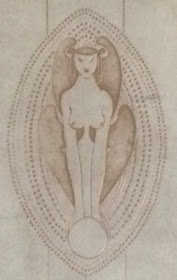Charles Ricketts is mentioned in this chapter (not in the index):
Literary culture dressed up its desires, clothing the object in preparation for the tantalizing opening of reading and its abstract pleasure by decorating both the cover and the inside of the book. Such dressing-up heightened the erotic attraction, linking sensual physicality and textual abstraction. Indicative of this unfolding of textual pleasure were the numerous erotic bookplates and markers designed by artists like Aubrey Beardsley, and by various artists in Germany and France. These sensual bookmarks and ownership tags demonstrated the intensification of the sexual element of book-ownership that arose in the latter part of the century, particularly under the influence of the Aesthetic movement.
(pp. 253-254)
 |
| Aubrey Beardsley, Mr. Pollitt's Bookplate |
Curtis assertions are made in a paragraph called 'The breast-bound book', which, by the way, is Marcel Duchamp's cover for Le Surréalisme en 1947. This is an indication of the ease with which Curtis jumps back and forth through time, from an example from 1863 in which books by female and male authors are not allowed to stand next to each other on the bookshelf, to a period in which sexuality was commented on and shown in a different way. His assumptions are not always based on facts. In this context Ricketts is mentioned.
Given the high percentage of publishing costs spent on binding alone, the widespread attention to bindings and their designs by publishers show how there was an economic return on catering to both the commodity and fetishistic reliquary value of text. Indeed a considerable number of covers from the period featured comely women, making the textual attraction quite specific.
Curtis mentions Louis Legrand's binding for Erastène's Cours de Danse Fin de Siècle (1894) with the 'grasped spread-leg of a Cancan dance', and Aubrey Beardsley's illustration for a prospectus advertising The Yellow Book, displaying 'a sensual woman, clad in black, and out alone at night, preparing to pick out a volume at a bookstall'. In between, he mentions Ricketts:
Charles Ricketts's erotic sphinxes on the binding of Oscar Wilde's The Sphinx (1894), were complemented on the frontispiece by a topless female wrapped in vines.
(p. 254)
 |
| Charles Ricketts, binding for Oscar Wilde's The Sphinx (1894): detail of front cover |
 |
| Charles Ricketts, binding for Oscar Wilde's The Sphinx (1894): detail of back cover |